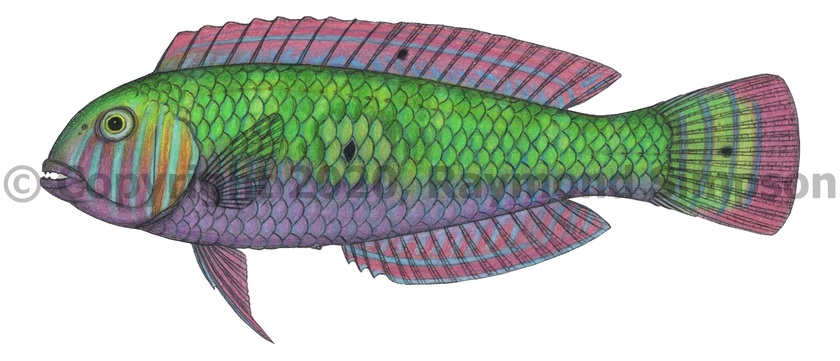
Common Name
Green Razorfish
Year Described
Castelnau, 1855
Identification
Dorsal Fin: IX, 12
Anal Fin: III, 12
Pectoral Fin: 12
Lateral Line Scales: 19-22 (anterior) + 5 (posterior)
Gill Rakers: 17-22 total
Caudal Rays: 14 principal
Body elongate and compressed. Forehead profile steep and convex. Mouth oblique and terminal. Upper jaw with a pair of enlarged canines flanked with smaller canines. Edges of preopercle and opercle smooth. Scales large and cover body. Head almost unscaled except for a few near upper opercle and on nape. Fins naked except for 2-3 rows on base of caudal fin. Dorsal fin long and low with the origin well forward (almost above eye). First two dorsal spines more flexible than remaining spines (anterior dorsal fin raised in juveniles with a deep notch behind spine two). Anal fin origin under last dorsal spine. Pelvic fin extends past anus, especially in males. Caudal fin truncate. Lateral line in two portions: the first arched and ending under 10th dorsal ray and the second short and straight on caudal peduncle.
Color
Terminal Phase: Body and head bright green grading to purple on the belly. Can express four sets of double pale bands. Scales with paler centers forming a reticulate pattern. Lower head and cheeks with bold orange and aqua bands. Flank with a patch of pale green and a small black blotch covering a single scale. Dorsal and anal fins pale to dark red with aqua stripes and spots. Caudal fin with green base and red outer half with thin aqua bands. Frequently expresses other black blotches (one on dorsal fin, and 1-2 on tail). Eyes with concentric rings of aqua and red. Initial Phase: body ranges from uniformly grass green to heavily mottled/banded in green or reddish. Can express heavy dark banding similar to the males. Fins also mottled. Lines on head like male but fainter. Eye reddish. Juvenile: Like female but much more heavily mottled brown/red/black with a cryptic checkerboard pattern. Front of dorsal dark and raised .significantly.
Size
Maximum size of terminal males to 150mm SL.
Habitat
Shallow (5-90m) sandy plains and seagrass beds.
Range
S. Florida to the southern Caribbean and southern Brazil, including the Gulf of Mexico. Also Bermuda.
References
Randall, J.E. 1965. A review of the razorfish genus Hemipteronotus (Labridae) of the Atlantic Ocean. Copeia 1965 (4), 487-501.
Other Notes
There are slight morphological differences noted by Randall (1965) between Caribbean and Brazilian populations of Xyrichtys splendens, that given the patterns seem between Brazilian/Caribbean fish faunas, may correspond to different species. Brazilian specimens consistently have the flank spot in a different location. Genetic and morphological studies over the entire range of this species needs to be done to confirm if there is one species or two. The name X. splendens would apply to Brazilian populations and X. ventralis is available for Caribbean material.